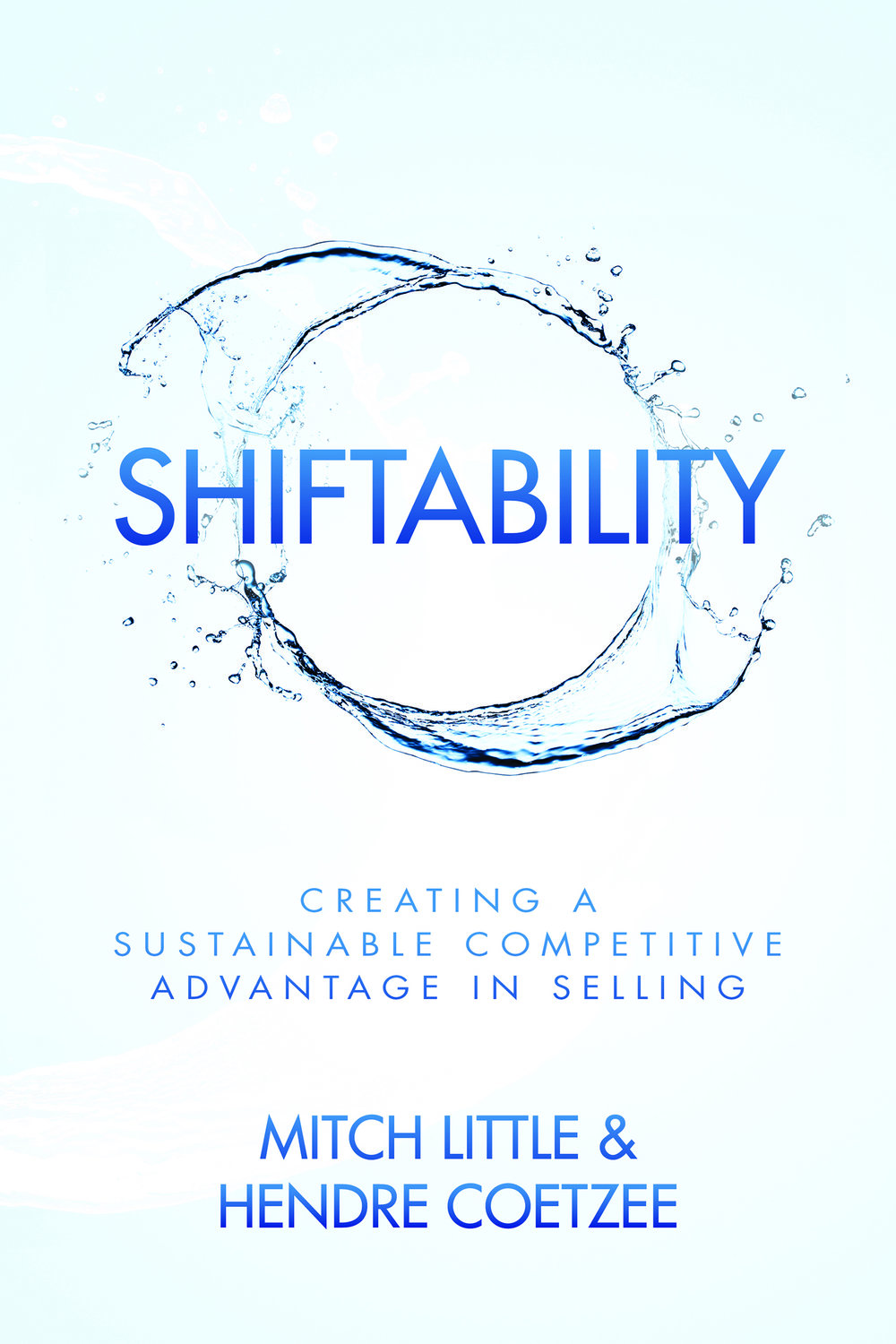INSIDER: Shiftability
Luke Smith, MBA
 Deepak Chopra, an American author and speaker, once said, “I am not a human thinking, I am not a human doing, I am a human being.” Throughout our daily lives, we have many options. We can change our jobs, our bosses, our cities, and try endless news sales methods. However, unless we undergo personal transformation ourselves, external changes will not propel us where we want to go or help us become who we need to be.
Deepak Chopra, an American author and speaker, once said, “I am not a human thinking, I am not a human doing, I am a human being.” Throughout our daily lives, we have many options. We can change our jobs, our bosses, our cities, and try endless news sales methods. However, unless we undergo personal transformation ourselves, external changes will not propel us where we want to go or help us become who we need to be.
Throughout Mitch Little and Hendre Coetzee’s Shiftability, the reader is introduced to six core mindset shifts that sales professionals should adopt to achieve success. While not directly written for the real estate professional audience, the book’s numerous applications present valuable insight for sales professionals of all career fields.
THINK POINT #1: That was Then... This is Now
It’s no secret that the sales profession of yesteryear is strikingly different than the sales profession of today. Before the dawn of the Internet, sales professionals held the secret key to a vault of information that would otherwise remain hidden.
But that was then... and this is now. Today, clients have access to limitless information via the Internet. Prospective homebuyers spend hours poring over potential homes, neighborhood information, and informational forums. Before realtors meet with their clients, clients often have a good idea of what they desire already – for better or for worse.
According to a CEB study of more than 1,400 B2B customers across different industries, 57% of purchasing decisions have been made before a customer talks to a supplier. Some naysayers are even decreeing the death of the sales professional.
With a seemingly negative outlook, realizing the value of a salesperson is pivotal. As a real estate professional, you hold valuable tools in your metaphorical tool belt. You know the area, know the market itself, and know the home-buying process better than your clients – and your skills are desired. You are the voice of reason when emotions run high and clients worry about committing to such a large purchase. You are an expert and coach that the Internet cannot replace.
It’s undeniable that the sales world has changed dramatically. But change is inevitable – it’s a fact of life. What’s more important is how we deal with changes that are thrown at us – how we respond to the challenges we face. Only then will we be able to succeed.
THINK POINT #2: Be a Doer and a Believer
Back in elementary school, we learned the order of operations for mathematics. While seemingly innocuous, these rules build the foundation of math in our daily lives. In much the same way, there is an order of operations for sales that often is mistakenly reversed.
As salespeople, we often believe that if we do certain things, we will then be able to have the things we want or need, and then will be successful (DO-HAVE-BE). Instead, it’s imperative that we shift our thinking and adopt the more transformative model of Be-Do-Have. According to the authors, “what we believe about our world and ourselves in the core of our being, determines what we will do, and ultimately the results we will have (Be-Do-Have).
Unfortunately, in the search for this shift, we often find ourselves facing limiting beliefs – beliefs that hold us in our current way of doing things. While not necessarily always bad, limiting beliefs hold us back and keep us fixed to a certain frame or set of variables.
Limiting beliefs can be organized into a few broad categories. Fear-based beliefs are rooted in our fears – fears of hurting people’s feelings or damaging relationships. As real estate professionals, we may fear hearing “no” and never ask for business from potential client.
Misguided or false beliefs are as simple as believing things that are not true – holding onto “conventional” wisdom without questioning it. As real estate professionals, we may hold onto antiquated selling methods dating back to our training long ago and refrain from adopting new technology or selling methods that could dramatically benefit our careers.
Misjudgment or overconfidence also limits us, especially as we interact with new clients and work to build relationships. Finally, experience-based beliefs lead us to doubt what we are selling or the resources we have available.
When we operate from these limiting beliefs, we will prove ourselves right. However, it is not until we counter these limiting beliefs that we can truly shift to being doers and believers. In order to accomplish this, we must recognize and expose the belief, explore the consequences of holding the belief, find alternative beliefs, and design new behaviors based on new beliefs.
THINK POINT #3: Be Like Water When it Comes to Client Engagement
One of the most influential martial artists of all time, Bruce Lee, initially trained in the tradition of Wing Chun as a young man. Later in life, Bruce developed his own integrated martial arts philosophy that contrasted with the often rigid and formal disciplines of traditional martial arts. His new system – Jeet Kune Do – emphasized practicality, flexibility, speed, and efficiency. According to Bruce, Jeet Kune Do “utilizes all ways and is bound by none and, likewise, uses any techniques which serve its end.”
In one of his most famous quotes, Lee describes what flexibility in form looks like: “Don’t get set into one form, adapt it and build your own, and let it grow, be like water. Empty your mind; be formless, shapeless – like water. Now you put water in a cup, it becomes the cup... Be water, my friend.”
 As a real estate professional, you’ve likely been told that there is only one right way to sell. But, as you likely know, the variation among clients almost instantly makes this a falsehood. In applying the principles of Shiftability, Bruce Lee’s concept of being like water rings truer than ever.
As a real estate professional, you’ve likely been told that there is only one right way to sell. But, as you likely know, the variation among clients almost instantly makes this a falsehood. In applying the principles of Shiftability, Bruce Lee’s concept of being like water rings truer than ever.
In order to stay relevant and effective in selling today, one should seek to employ one of four different styles of client engagement depending on the time, role, and circumstances. These four styles move from simpler engagement to more complex interactions:
- Product Selling: The most basic level of engagement, product selling involves offering simple product answers to basic product requests. While the Internet has effectively made this level obsolete in many ways, it remains the backbone for many sales interactions and can assist in moving to more complex interactions.
- Solutions Supplier: Being a solutions supplier requires more knowledge of your company’s ecosystem and how to assist clients in accomplishing their goals. For a real estate professional, this may be the initial step in the selling process – helping a prospective buyer or seller understand the real estate market and providing initial options.
- Trusted Advisor: As a trusted advisor, clients seek us out for input and ideas to help them solve business or personal problems. This may or may not be outside the realm of the sales professional’s knowledge. As a trusted advisor, clients will reach out and call on you to help them with matters that are not even related to services that you provide.
- Insight Provider: While an insight provider is similar to being a trusted advisor, the role is more proactive, requiring significant research and preparation work before you offer up what you have created. In order to be prepared, one must understand, create, and deliver the first insight offering.
By utilizing an engagement technique conducive to the needs and goals of a client, sales professionals can build trust and rapport while demonstrating value for myriad clients.
THINK POINT #4: Tailor Your Insight
Of course, in order to become a proactive Insight Provider, one must understand how to best tailor one’s insights to the needs of the client. According to the authors, insight is information-unique knowledge that you can bring to the client that teaches them something new that may reframe what they are already thinking or open up a new train of thought.
For a real estate professional, providing valuable insight is the hallmark of a good sales relationship. Providing worthwhile ideas and suggestions to clients will undoubtedly result in returning clients and referrals as you look to grow your network.
In order to be effective, insight should bring something new to the client, should point to a solution that you can actually provide, and should lead your clients to making a decision. Highly personalized insight tailored to your specific client will lead to a strong bond and a positive sales relationship.
Personalized insight is highlighted by three key drivers. First, personalized insight is discovered – it must arrive through two-way conversations filled with thorough listening. In a similar fashion, personalized insight is co-created with the client through effective communication. This involves careful listening, asking good questions, and a genuine curiosity to explore. Finally, personalized insight is tailored to a specific person or client company. This involves a deep understanding of what the client values and where they are in the decision process.
Providing personalized insight to real estate clients doesn’t need to be difficult. Remember, you are the expert. No real estate website can provide the valuable information you hold about the real estate markets of your adopted cities. Your only task is to work collaboratively with your clients to discover – through listening – what their goals are and work hard to help them accomplish them.
Conclusion
Whether we want to believe it or not, the world is changing before our eyes. While we respond well to present changes, we must discover how to adapt to continuously changing conditions in the world of sales. By shifting one’s mindset and understanding the changing climate, we can remain meaningful contributors in a dynamic sales environment.
. . . . . . . . . . . . . . . . . . .
Recommended Reading
Little, Mitch and Coatzee, Hendre (2016), Shiftability: Creating a Sustainable Competitive Advantage in Selling, North Charleston, SC: CreateSpace Independent Publishing Platform.
. . . . . . . . . . . . . . . . . . .
About the Author
Luke Smith, MBA
Baylor University
Originally from St. Louis, Missouri, Luke earned a Bachelor of Business Administration degree in Economics from Baylor University in 2014 and a Master of Business Administration in Healthcare Administration in 2017. Before beginning graduate school, Luke served as Special Assistant to the President at Baylor University. Luke currently works for Kaiser Permanente Health System in San Francisco, California.